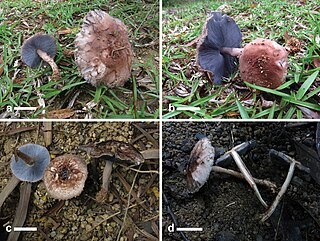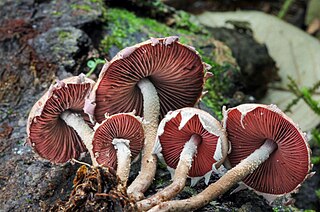Related Research Articles

Lycoperdon is a genus of puffball mushrooms. The genus has a widespread distribution and contains about 50 species. In general, it contains the smaller species such as the pear-shaped puffball and the gem-studded puffball. It was formerly classified within the now-obsolete order Lycoperdales, as the type genus which, following a restructuring of fungal taxonomy brought about by molecular phylogeny, has been split. Lycoperdon is now placed in the family Agaricaceae of the order Agaricales.

Lepiota is a genus of gilled mushrooms in the family Agaricaceae. All Lepiota species are ground-dwelling saprotrophs with a preference for rich, calcareous soils. Basidiocarps are agaricoid with whitish spores, typically with scaly caps and a ring on the stipe. Around 400 species of Lepiota are currently recognized worldwide. Many species are poisonous, some lethally so.

The Agaricaceae are a family of basidiomycete fungi and include the genus Agaricus, as well as basidiomycetes previously classified in the families Tulostomataceae, Lepiotaceae, and Lycoperdaceae.

Coprinus is a small genus of mushroom-forming fungi consisting of Coprinus comatus—the shaggy ink cap (British) or shaggy mane (American)—and several of its close relatives. Until 2001, Coprinus was a large genus consisting of all agaric species in which the lamellae autodigested to release their spores. The black ink-like liquid this creates gave these species their common name "ink cap" (British) or "inky cap" (American).
Clarkeinda is a genus of fungi in the family Agaricaceae. According to the Dictionary of the Fungi, the widespread genus contains five species. Species in this genus, especially Clarkeinda trachodes, are only distributed in south Asia and southeast Asia.
Crucispora is a genus of fungi in the family Agaricaceae. The genus, described by mycologist Egon Horak in 1971, contains two species found in New Zealand and Asia.

Floccularia is a genus of fungi in the order Agaricales. There are four recognized species in the genus, which have a widespread distribution, especially in northern temperate regions. Two former species are now classified as a Cercopemyces and an Amanita. Floccularia was circumscribed by Czech mycologist Zdeněk Pouzar in 1957.

Gastropila is a genus of fungi in the family Agaricaceae. The genus, described in 1973, contains four puffball-like species distributed in the Americas.
Glyptoderma is a fungal genus in the family Agaricaceae. It is a monotypic genus, containing the single species Glyptoderma coelatum.

Heinemannomyces is a fungal genus in the family Agaricaceae. This is a monotypic genus, containing the single species Heinemannomyces splendidissima, which was defined in 1998 by Roy Watling. It is found in peninsular Malaysia and China.

Leucoagaricus is a genus of fungi in the family Agaricaceae. Several fungus-growing ants cultivate multiple species for food. The genus contains approximately 90 species.

Melanophyllum is a genus of fungi in the family Agaricaceae. The widespread genus contains four species.

Montagnea is a genus of fungi in the family Agaricaceae. The genus has a widespread distribution in subtropical dry areas, and contains six species. Montagnea was circumscribed by Swedish mycologist Elias Magnus Fries in 1836.

Panaeolopsis is a genus of fungi in the family Agaricaceae. The genus has a widespread distribution and contains four species. Panaeolopsis was circumscribed by Rolf Singer in 1969 with P. sanmartiniana as the type species.
Rugosospora is a genus of fungi in the family Agaricaceae. The genus contains two species: R. ochraceobadia, found in Africa, and R. pseudorubiginosa, found in Colombia and Mexico. These species have fruit bodies (mushrooms) with free gills, a white spore print, and a ring on the stipe. Rugosospora was circumscribed by Belgian mycologist Paul Heinemann in 1973.
Secotium is a genus of fungi in the family Agaricaceae. The members of this genus are closely related to ordinary Agaricus mushrooms, but do not open out in the usual way; this has given rise to the term "secotioid" for such mushrooms in general. They are thought to form an evolutionary link between agarics and gasteroid fungi. Secotium is a widespread genus, with species that are predominantly found in warm and arid regions.
Physocystidium is a genus of fungi in the family Tricholomataceae. This is a monotypic genus, containing the single species Physocystidium cinnamomeum. This species is found in Trinidad, and was originally described as new to science in 1951 as Collybia cinnamomea by mycologist R.W.G. Dennis; Rolf Singer transferred it to the then newly created genus Physocystidium in 1962.
Morganella is a genus of puffball fungi in the family Agaricaceae. The genus name honors American botanist Andrew Price Morgan (1836–1907). The widely distributed genus is prevalent in tropical areas. A 2008 estimate placed nine species in Morganella, but several new species have since been described.
References
- ↑ Heim R. (1929). "Sur les hyphes vasiformes des Agaricacés". Comptes rendus hebdomadaires des séances de l'Académie des Sciences (in French). 188: 1566–1568.
- ↑ Kirk PM, Cannon PF, Minter DW, Stalpers JA (2008). Dictionary of the Fungi (10th ed.). Wallingford, UK: CAB International. p. 522. ISBN 978-0-85199-826-8.